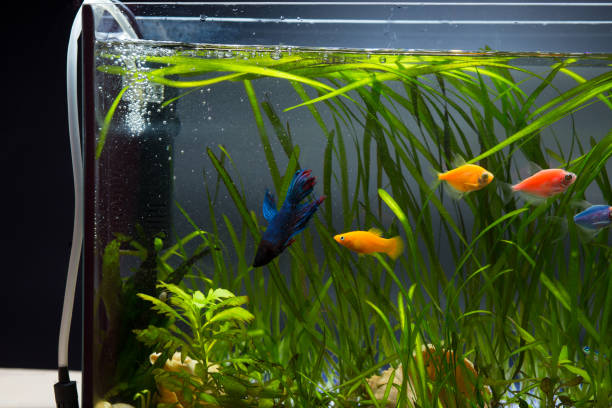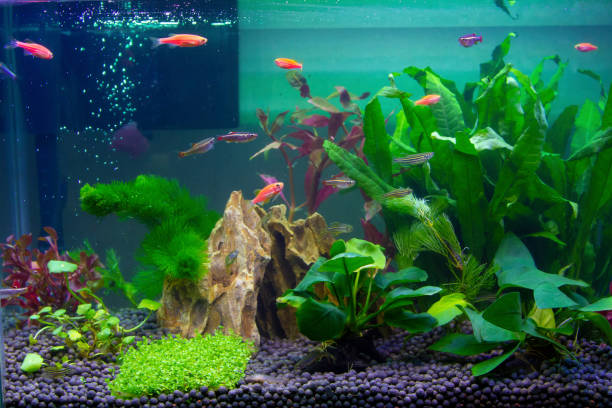All animals need oxygen to survive, and fish is no exception. Providing enough oxygen to your aquarium is essential to keeping your aquatic inhabitants healthy.
But can too much oxygen kill fish? It sounds like a no-brainer question, but the answer is more complex than many think. Keep reading to explore!
Contents
Can Too Much Oxygen Kill Fish?

If you give too much oxygen to your fish, they can suffer from gas bubble disease. Hyperoxia can also occur in this case.
The good news is that your fish is unlikely to be killed in these circumstances.
Gas Bubble Disease
Gas bubble disease typically occurs due to exposure to water supersaturated with glasses, such as nitrogen, carbon dioxide, and oxygen.
Here are several signs of this disease:
- Gas bubbles form in gills, eyes, skin, and fins.
- Problems related to floating (due to the higher amount of gas in the body) and your fish can start upside-down swimming.
Hyperoxia
In hyperoxia, your fish will hyperventilate, but venous and arterial blood oxygenation still rises. While high blood oxygenation levels happen in hyperoxia, it does not lead to a lowering of blood oxygen-carrying capacity.
In addition, hypoventilation (occurring in hyperoxia conditions) will lead to carbon dioxide retention, causing respiratory acidosis.
Moreover, simultaneous changes to the antioxidant defense systems and a higher level of oxidative stress can happen because of hyperoxia.
[display-posts id=”2620″ image_size=”thumbnail” posts_per_page=”1″]
Signs of Too Much Oxygen in Fish Tank
Generally, dissolved oxygen levels in fish tanks are recommended to be about 6 to 8 mg/l and 80 to 110% oxygen saturation.
But if your aquarium has dissolved oxygen levels above 115%, it will most likely lead to gas bubble disease in fish.
You can use a dissolved oxygen meter to determine if your fish tank has too much oxygen. If the reading stays within the recommended range, you can expect your fish tank not to have too much oxygen.
Furthermore, it would be best if you asked the following questions to yourself:
- Are my fish swimming normally in my aquarium?
- Do my fish look fine and healthy, just as they usually look?
- Are your fish eating normally? How is the appetite?
If the answers to the above questions are normal and yes, it is unnecessary to worry much about the oxygen in your tank.
If everything seems normal, including the fish’s health, behavior, and appetite, that is a sign your tank does not have too much oxygen.
Common Causes of Too Much Oxygen in A Fish Tank

Temperature Change
If the temperature increases, the oxygen solubility will decrease. The fact is that cold water typically holds more dissolved oxygen than warm water.
In other words, water can hold less oxygen as the temperature increases.
Photosynthesis
In nature, water supersaturation is frequently found in large dams and waterfalls.
When the water flows over the waterfall, it will trap and carry the air with it. Then eventually merges into the water.
The higher depth will be the hydrostatic pressure. So it also contributes to raising the saturation levels to more than 100 percent.
Too Much Aeration
In nature, plants that live in daylight undergo photosynthesis. As we all know, oxygen is the result of this process.
So aquatic plants can also increase the amount of oxygen in the aquarium by releasing a lot of oxygen as the by-product of photosynthesis.
[display-posts id=”1858″ image_size=”thumbnail” posts_per_page=”1″]
How to Avoid Too Much Oxygen in Fish Tanks?
- Add more plants to your tank. They consume excess oxygen and leave a higher concentration of CO2 in the water, which is essential for your fish.
- Install a bubbler or airstone near the surface of the aquarium. It will pull out the excess oxygen from beneath the scales of fish’s bodies.
- Change the water in your aquarium more often than you usually do.
- Consider adding a filter or powerhead so that water is circulating.
- Monitor your water parameters to make necessary adjustments promptly.
- Watch for signs of too much oxygen in the aquarium, which is the same as when ammonia or nitrate levels are too high. So watch out for those signs.
FAQs
1. How to Tell the Right Amount of Oxygen for a Fish Tank?
Fish need oxygen to live, and the amount of oxygen needed in your tank can be calculated based on the shape and size of the tank.
The more open and larger a tank is, the more oxygen there is. For instance, a fish living in a narrow and long glass tube will need less oxygen than one in a big open vase.
2. What Are the Pros of Having a High Oxygen Level in Fish Tanks?
- Increase metabolism and the ability to eat and swim.
- Increase the ability to remove nitrite, ammonia, and nitrate waste products safely.
- Increase metabolism in your fish, helping them grow and fight off diseases.
3. How to Prevent Oxygen Dosing Issues in a Fish Tank?
You can use a water quality monitor, which will give you readings of the water quality every hour.
4. How Can I Tell if My Fish Tank Is Too Low in Oxygen?
If your tank has too little oxygen, your fish may start to behave strangely and show some signs of illness.
[display-posts id=”3522″ image_size=”thumbnail” posts_per_page=”1″]
5. Can Fish Recover From Too Much Oxygen?

No. High oxygen levels will cause hyperoxygenation, stressing your fish and other organisms, and is dangerous for invertebrates such as shrimp or crabs.
Wrapping It Up
Can too much oxygen kill fish? No, but it is best to make sure your aquarium contains the right concentration of dissolved oxygen.
We hope all your doubts and queries are now cleared. Thank you, and happy fishkeeping!

